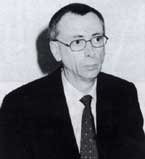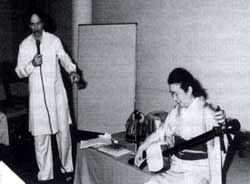EVENTS
Poetry and Performance

Exploring the connection between poetry and performance are growing feature of the work of Dr. William Radice. At a lecture in IGNCA (March 13) he spoke about this, mentioning in particular his poems Gifts (2002), his Myths and Legends of India (2001), his recently completed trilogy of long poems, his translation in progress of Michael Madhusudan Dutt’s Meghanand-badh Kabya, and the poetry and music programmes he has started to do with his daughter Helen, a professional harpist.
Dr. Radice, author or editor of nearly 30 books is well known for his translations of the poems, stories and plays of abindranath Tagore. He translates from German as well as Bengali, and has recently publishedTraces of My Father, a translation of Vastersupuren, an autobiographic novel by Sigfrid Gauch. In India, his latest books are ‘A Hundred Letters from England’ and ‘Poetry and Community: Lectures and Essays, 1991-2001′.
Dr. Radice discussed during the lecture whether, in an age of multi-media, poetry needs to be liberated from the printed page. He has published six books of his own poem and he is Senior Lecture in Bengali at School of Oriental & African Studies, University of London.
|
|
India-Japan Classical Cross-overIndian and Japanese music traditions and musical instruments accord careful attention to melody and rhythm, while Western music and its instruments are built around harmony. In both India and Japan, vocal music is central and microtone (shruti) is an important element of melody, and the performance progresses from slow to medium to fast (vilambit-madhya-drut, or jo-ha-kyu in Japan). Furthermore, the Japanese language is closer to Indian languages in phonetic, grammatical and poetic structure than it is to Chinese or Western languages. Prof. T.M. Hoffman, an expert exponent of Indian and Japanese music at a lecture-demonstration in IGNCA (March 17) said there is a great potential for sharing between Indian and Japan in relation to musical and linguistic arts, and such interaction can promote understanding and development within and between the respective traditions and in the broader context of music in Asia and the world.
|
|
He spoke about some Japanese musical instruments and explained how they can be adapted to Indian music. Shakuhachi is the Japanese vertical flute, made from the lower (including root) portion of bamboo, with five finger holes. Producing a wide dynamic and tone quality range, it is performed solo in the meditative honkyoku style, together with koto and shamisen in traditional trio ensemble sankyoku, infolk music, and in a wide variety of modern music. A vertical flute like shakuhachi is found in ancient cave paintings of Bhimbetka, near Bhopal. Koto is the Japanese zither, made in paulownia wood and with (usually) 13 strings of wound silk or nylon. Strings are plucked with plectra tsume made of ivory or plastic worn on the thumb, forefinger and middle finger. An instrument like koto is known as Narayan veena in India. Shinobue is a horizontal bamboo flute resembling the Indian bansuri, (flute) with six finger holes. It is used mainly in festival ensembles and other folk music and dance. T.M. Hoffman, born 1951 in Pennsylvania, is a master in Indian and Japanese music – vocal and flute. He has traveled worldwide promoting the two steams of music. He had delivered a lecture in IGNCA last year (Events, March-April 2002) on ‘Aural Arts Across Cultures’ highlighting the aural arts in India and Japan.
|
|
|
|
Knowledge at DoorstepsDr. Om Vikas, Director, Department of Information Technology in the Ministry of Communciation & Information Technology presented the various sources of knowledge in his lecture “Knowledge at Doorsteps” (March 21st). Some of the sub-themes of his lecture included ‘The emergence of knowledge-based Society,’ ‘Technology shrinks distances in real time,’ ‘Increasing returns in knowledge economy,’ ‘Linguistic pluralism,’ ‘e-content and universal access.’ ‘World knowledge in natural language.’ He raised and answered fundamental questions in IT like ‘Is there Gain in knowledge or Loss of Knowledge?’ and ‘Is the technology to Divide or to Unite?’ Tracing the technological development, he said while the writing system was invented over 500 years ago, the first written book came only in 1300 BC, and the printing press was invented in 1450 AD. The development in the information revolution, in contrast has been fast, in waves of quick succession. He also discussed the various aspects of the information technology, including accessibility, proliferation, language barriers that needed to be crossed as also the need to incorporation IT in the routine system. The objective of the power-point presentation of Dr. Om Vikas was to discuss the IT scenario world over and with special reference to India.
|
|
|
Poetic Culture of KalidasaKalidasa, justly recognized as Kavikulaguru (Master of the Poet fraternity), is a great luminary in the field of Sanskrit literature. He is an outstanding poet of our country and also one among the few all time great writers of the world. In him we see a true successor of the two great sage poets Valmiki and Vyasa. He possesses the aesthetic sense and technical skill of poetry of both these poets of universal vision. Kalidasa’s vision unfailingly brings out the finest and the loftiest aspects of our culture. The impression is as sublime as that of Vyasa while his expression is as tender as that of Valmiki. His is the most authentic and equally attractive representation of Indian values eternally relevant for the well being of the mankind. In him one can unmistakably notice the rare and the long cherished combination of beauty and sublimity, warmth and wonder, love and loftiness, mirth and mysticism. Sensual and spiritual features find an undisputable blissful conclusion in his writings. Kalidasa is never loud and is ever profound. In him the Sanskrit language has seen the best blend of sound and sense, form and content, idiom and emotion and expression and experience.
|
|
Our heritage has handed over seven works of this universal poet, which include two lyrics (Rtusamharam and Meghadootam),and three plays (Malavikagnimitram, Vikramurvaseeyam andAbhijnanashakuntalam). An in-depth study of his work shows that these seven available works of Kalidasa are the products of his quest for the realization, in Indian concept, of dharma, moksha etc. Thus we have his escalating vision making experiments on the theme of Kama (desire), which in its widest stretch encompasses the whole mankind, leading towards the need for Dharma (Rightousness) to manage Artha (means) for, this alone tries to meet the demands of Kama. Ultimately it is the concept of Moksha (liberation) which an “Akamahata” mind can only realize, is the outcome of this spiritual quest. Here again the true spirit of Moksha is not an exclusive one for, it is within and beyond the purview of the trivargas viz. Dharma, Artha and Kama. Kalidasa has become overwhelmingly successful in bringing out his own original model through his rewarding artistic and meditative experiments in his Rtusamharam, Malavikagnimitra, Vikramurvaseeyam, Meghadootam, Kumarsambhavan and Abhijanas Shakuntalam respectively. His practical application of the poetic revelations brought through the said six works is seen in his magnum opus – Raghuvamsham – truely a national epic of international nay, universal standards. Raghuvamsham is the distilled essence of universal human values in general and Indian culture in particular. Kalidasa is the only poet to describe in detail, the flora and fauna of this land, the fascinating geographical vividness of this country and the rich regional peculiarities of our nation. It is quite interesting to note that the poet describing our country at three levels – viz. Bhumarga (in Raghuvamsham IV Canto), Meghamarga (in Meghadootam) and Vimanamarga (in Raghuvamsham XIII Canto) suggesting the three spiritual planes of the Vedic wisdom viz. the Bhuh-Bhuvah-Suvah. Such revealing visions are many folded in Kalidasa. It is redundant to say that he is a master in Sanskrit, the medium of his writings. Sanskrit, in fact, saw its great moments of perfection and profundity in his works. His erudition in the fields of grammar, prosody, poetics and others skills are naturally undisputable from the viewpoint of aesthetics. Simultaneously, his mastery over the subjects such as astronomy, astrology, philosophy, Vedic learning, agriculture, botany, polity, economy, morality, ethics, music, dance, theatre, paintings, sculpture, psychology etc., are also evident from his writings. Thus in him one can discover the whole heritage of India and the golden age of the Guptas. To sum up, Kalidasa, even today, remains as an unattainable standard in the art of poesy coupled with the spirit of values.
Special Lecture Dr. R. Ganesh, Research Officer in IGNCA – Southern Regional Centre, Bangalore, delivered a special lecture at IGNCA, Delhi on April 29. Here he presents the excerpts of his lecture. |
|







